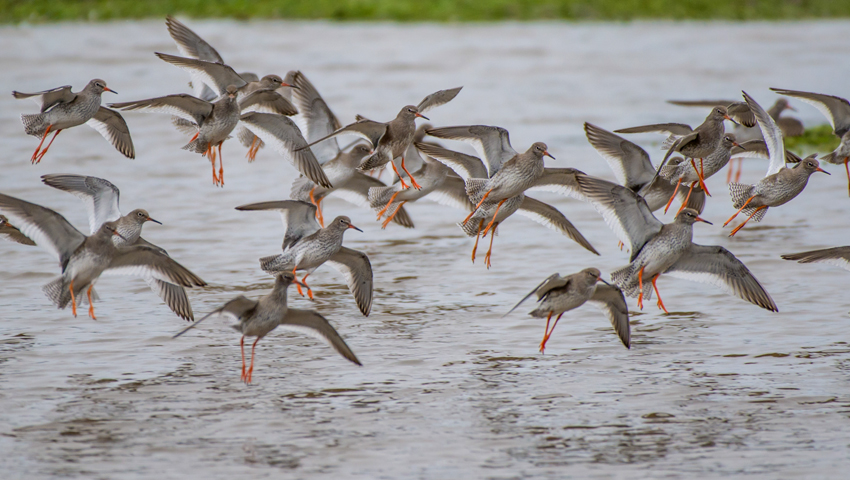For the first time, a full breeding survey of redshank has been carried out along areas of the east coast wetlands, with results showing the Humber and North Norfolk alone hold 5 per cent of the entire UK population, which totals over 1,000 breeding pairs.
The wading bird has undergone dramatic declines across the UK, with the most recent research showing a 53 per cent loss of the breeding population on saltmarshes. The new data will therefore provide the vital baseline required for conservationists to take action and help secure their future in the UK.
Redshank, a medium-sized wading bird with bright orange-red legs, are an Amber listed species that breeds in the UK, with large numbers also migrating here from Iceland to overwinter. They have a distinctive alarm call that has given them the nickname ‘warden of the marshes’ as they are often the first to be heard when a potential threat appears. They feed on a range of insects, molluscs and crustaceans by probing their long bills into soil and mud.
Saltmarsh is a crucial habitat for redshank, with up to three quarters of pairs breeding on saltmarsh in England and half of the Welsh population breeding on this habitat too. Whilst the bird does also utilise lowland wetland and upland grassland habitats, long-term declines are being experienced across all three habitats.
Work on saltmarsh birds is part of a wider EU LIFE funded LIFE on the Edge project. The study, led by the RSPB and part-funded by Natural England, recorded 419 breeding pairs of redshank on the Humber estuary and 597 breeding pairs in North Norfolk, making up 5 per cent of the UK’s entire breeding population. The areas also support other coastal waders such as avocet, oystercatcher and ringed plover. With a loss of 53 per cent of breeding redshank from saltmarshes between 1985-2011 alone, the areas of saltmarsh found within the east coast wetlands, as the new study showed, have never been more important for the vulnerable species.
As Audrey Jost, RSPB Coastal Species and Habitats Officer, explained, “We’ve always thought saltmarsh is the most important habitat for redshanks, but we only had limited data to back this up – even we’re surprised at the number of birds recorded. Understanding where redshank populations are faring well, or not so well, across the country is the first step to developing conservation efforts to help protect them for years to come.”
Across other parts of the UK, growing numbers of breeding redshank have been recorded in Wales, with RSPB Ynys-hir nature reserve hosting 59 pairs this season up from 45 last year. Whilst these numbers might seem smaller in comparison to England’s east coast, it is estimated that only about 190 breeding pairs of redshank are present in Wales, with 55 per cent of this population under management by the RSPB.
Meanwhile, whilst the study showed positive numbers in East Yorkshire and Norfolk, results for breeding redshank further down the coastline have not fared so well. As redshank are considered an indicator species for saltmarshes, where populations of the bird are declining, this acts as an early warning sign of saltmarsh deterioration.
Jost added, “We know that in places like Suffolk and Essex, breeding redshanks are less common than they used to be. The saltmarshes in these areas have been severely impacted by sea level rise, coastal erosion and development – when this happens, redshank are often one of the first species to disappear. Without healthy saltmarshes, our native wildlife will suffer and these coastlines will also be more vulnerable to flooding and less able to store carbon. We need to ensure places like the Humber and North Norfolk coast stay healthy for our wildlife and to challenge the effects of climate change, while continuing with conservation efforts to help create suitable feeding and breeding habitat for redshank, including for the significant populations supported by RSPB nature reserves.”
Resident breeding redshank are also joined by migratory birds each winter, with UK saltmarshes and mudflats supporting thousands more of the species over the colder months. Working at a flyway scale for the conservation of redshank therefore also continues to be important, with the RSPB working with their BirdLife partner in Iceland, Fuglavernd, to re-wet and restore peatlands there – breeding habitat for many of the birds that migrate to winter in the UK.
